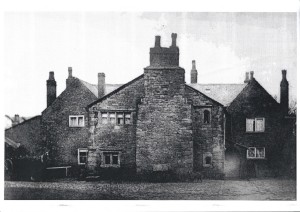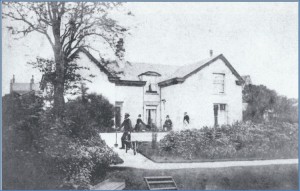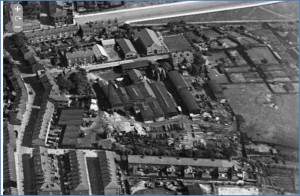A Brief History by Cliff Ivers, August 2014
Introduction
The history of Middleton’s Bradshaw Hall and Estate has never been compiled. This brief history is therefore intended to summarise the written data and records available for Bradshaw from the 13th to the 20th century. It also includes references to the social history of the area in terms of modern urbanisation and industrialisation.
The estate was a key part of the post-medieval manorial system of North Manchester. It was occupied by descendants of the ancient Chadderton family from 1548-1820 and comprised of a large part of the current Middleton Junction and Jumbo area. The remains of the Hall lie beneath private land off Glenn Grove (SD8848 0501). Although demolished in 1910, it is of significant archaeological interest as the footprint of the hall has not been built upon and the site may contain evidence of earlier occupation.
Figure 1 shows the rear of the Hall in about 1900. The centre of the building appears to be in the style of a medieval hall. The different styles of mullion window could suggest that this part of the hall could have been built in several phases. Also the use of four mullions in the upstairs window may suggest some usage for hand-loom weaving. The two side gables are later extensions. The appearance of a horse, cart, dog and kennel suggest it was a working farmhouse at the time of the photo.
The History of the Estate
The first recorded evidence to the Bradshaw area is a 1320 survey of the Barony of Manchester[i] which records a ‘Bruyd-shaw’ (Broad Wood) in the vicinity of ‘Alcryn-ton’, ‘White Moss’, ‘Black-ley’ and ‘Nut-Hurst’. An 1839 map confirms the area as Broad Wood whilst later ordinance survey maps show both Bradshaw Hall and Bradshaw Fold in the same area. There is a record of the ownership of the land in the will of Robert Chadderton a “Yeoman of Bradshaw Hall” in 1639[ii]. It refers to previous owners of the land as; – The Priory of St John of Jerusalem, Roger de Montbegon (d 1266) and the Earls of Derby.
Due to the close location to Chadderton Hall, it is likely that Bradshaw was originally part of the Manor of Chadderton which was passed to Gilbert de Notton in 1212 and to Richard de Trafford in 1232. Richard’s second son Geoffrey inherited the land and took the name Geoffrey de Chadderton and built Chadderton Hall in the mid 13th Century. The Chadderton manor was passed to the Radcliffe family by 1367[iii] and subsequently to the Assheton family in 1454. The Radcliffes were later to settle in Foxdenton, and the Chadderton family went on to establish both Nuthurst (Moston) and Bradshaw Halls. The Asshetons also held the Manor of Middleton which at this time was defined as the area west of the Irk. Neighbouring Alkrington remained in the ownership of the Prestwich family later to transfer to the Langley family.
The Chadderton family can be identified as having a presence in the area of Bradshaw as far back as Edward VI (1547) when Edmund Chadderton was a plaintiff in a civil court action against John Tonge and others for trespass on the common turbary of Tonge Moor[iv] . The eastern side of the Tonge manor is bounded by the Irk River and Wince Brook so Tonge Moor must have been the area between Tonge Hall and Bradshaw Hall.
Edmund had also begun a property dispute[v] some years earlier in the reign of Henry VIII (1532). This concerned an area south of the Bradshaw Hall site and related to an area known as Theymore Waste. The dispute involved the borders of the Nuthurst Waste , Chadderton Waste, Oldham Waste, Moston Hamlet and Ashton Township. The dispute continued for over 70 years with Theymore borders being redefined and a common area left known as the ‘Equals’. Edmund Chadderton held the smaller of two Halls at Nuthurst which was 2 miles south of Bradshaw Hall. His eldest son was William Chadderton (1540-1608) who became the Bishop of Lincoln and Chester.
We find the first reference to Bradshaw Hall in the will of Robert Chadderton in 1639. The ancestry of Robert is unclear but we can assume he is related to the Nuthurst hall branch and Edmund Chadderton’s line because of the closeness of the two estates. Roberts’s first son was named Edmund and this provides further support to this assumption.
It should be noted that although this is the first documentary evidence of the occupation of the site, the Chadderton family could have been here as early as 1367 following the transfer of Chadderton Hall to the Radcliffe’s.
Edmund Chaddertons son or grandson (Edmund) sold the Hall at Nuthurst in 1623 and moved to Yorkshire. The Chaddertons at Bradshaw appear in the Middleton Parish Records as early 1548 and were described as Yeomen (Free men owning a farm) but seem to have mostly died off by 1820.
It has been speculated that the hall is connected with the infamous Regicide Lord President John Bradshawe (1602-1659) who attended Middleton Grammar School in the early 17th Century[vi]. There is no evidence for this or to any connection with the seat of the ancient Bradshaw family who had a large hall in Bradshaw, Bolton- le-Moors.
Urbanisation of the Estate
In the 16th Century, the area consisted largely of undeveloped forest and meadow. The Hall was located on the south side of a valley overlooking the Wince Brook. The Estate had a corn mill on the river and began to rent land to farmers. The Hall site had a saw mill operational in the 19th century however it is unclear when the estate first began to process timber. The 1840 tithe records refer to a ‘Kiln field’ on the estate suggesting some possible drying of corn.
In 1777, the silk weaving business was introduced to the area and for the next 50 years there was great demand for hand loom weaver’s cottages. The Estate rented out land north of the current Grimshaw Lane and the settlements of Jumbo and Bradshaw Fold rapidly grew.
In 1779, Thomas Chadderton sold the coal rights to the estate which were probably accessed from the Alkrington pit at Lancashire Fold. The Rochdale canal was built shortly after this greatly easing the transportation of both coal and cotton.
In 1828, John Lees established the Greengate Brewery close to the hall. Following the construction of the railway branch line to Middleton in 1842, the area became known as Middleton Junction and large cotton mills were built locally in areas such as Mills Hill and Grimshaw Lane. The estates old corn mill at Wince Brook developed into a weaving shed and later became Bradshaw Mill owned by Richard Ashworth & Sons. The remnants of this mill are still clearly visible at the side of the brook (near the modern bridge)
By the middle of the 18th century, the weavers cottages were being been replaced by brick terraced property to provide accommodation for mill workers. The Cotton Mills were in decline by 1910 and most were closed by the 1950’s
Prior to the establishment of the Borough of Middleton in 1886 the Bradshaw Estate was located in the township of Alkrington which was in the Parish of Prestwich cum Oldham. Figure 2 is a Map[i] of the Civil Parishes of Radcliffe and Prestwich showing the Bradshaw Estate nestled in between Alkrington, Tonge and Foxdenton.
Figure 3 shows the layout of the site in 1893. Well Street was subsequently replaced by Glen Grove. The Hall has gardens and a pond to the south west aspect and stables to the North West. The timber mill was extended over Orlando Street at a later date. Bradshaw Fold is no longer identified but it is believed to have been in the area between the Hall and Green Hill.
Occupiers of the Hall
The Chaddertons were the main occupants of the hall and feature regularly in the St Leonards parish records from 1548 until the early 19th century. A newspaper cutting of 1862 reports that the owner of the hall ‘Old Tommy Chatterton’ had died some years earlier[i] (1820) and the hall had passed to a descendant named James Smith this ended occupancy by the Chadderton line.
James died in the 1850’s and the freehold to the estate and hall was auctioned in 1891.
In the 1860’s Henry Whalley, the Manager of Grimshaw Mill occupied the hall; he and his wife may appear in figure 4.
John Booth moved into Hall in the 1880’s and the property began to be run as Bradshaw Hall Farm. John died in 1891 and the tenancy of the farm was passed to William Barlow Wood.
The picture in figure 5 is probably some years later than the previous one, and is taken from a camera position about 45% to the right giving a south easterly perspective. The Hall appears to have lost some of the wooden guttering that was evident on the first photo and it can be seen where the exterior painting ended at the side of the house. It looks as though the picture was posed. The chap with the basket is walking up from the allotments or market gardens that were between the hall and Wince brook. The other chap is leaning on a structure which could be a WC or pump house. There are a number of wells and springs located on old maps however there is no sign of a brook or stream in the area currently.
Jonathan Partington, a local building contractor purchased the site at the turn of the 20th century. He developed the saw mill and began some metal casting to support maintenance of the local mills. Apparently this developed into a retail hardware business allowing locals to buy hardware such as screws nails and hinges (Described by a local as the forerunner of B&Q!).
Unfortunately the hall was demolished about 1910. An aerial photograph of 1926 (fig 6) shows the industrialisation of the area. The terrace at the bottom of the photograph is Glen Grove and Greengate runs across the top of the picture. The area where the hall was located is being used for storing timber (bottom centre).
In the 1930’s the site became a motor vehicle scrap business and is currently owned by Walter Taylor & Co.
Jumbo and Bradshaw Fold Local History
The early Bradshaw Hall estate comprised of the hall, farmland and meadow which was bounded on the south by Wince Brook, the west by Tonge and in the north by Chadderton. The only access to the estate road would have been the lane to Foxdenton Hall, later to become Grimshaw Lane.
Two settlements were formed firstly by the home weavers and later by the Mill owners. Bradshaw Fold was the area on the North East of the estate, later to be replaced the station name, Middleton Junction. In the 1861 census, Bradshaw Fold had over 70 weaver’s cottages.
On the West, between the current Aspinall Street and Sandy Lane was the village of Jumbo or Jumba. Nobody seems to have an explanation of the name so I carried out some research;
In an 1823 slang dictionary,a Jumbo is defined as a clumsy or unwieldy fellow. The origin of this expression is based on a well read travel book ‘Travels in Africa’[i] . It describes a tribal custom in Africa where a witch doctor would dress up and perform a noisy dancing ritual. He was known as Mumbo Jumbo. Incidentally, the dance would culminate with Mumbo tying up a woman (typically a quarrelling wife) and beating her with a large stick, although I do not think this is relevant to our story…
The alternative derivation of Jumbo is a Swahili name for an elephant and was given to a famous occupant of London Zoo who travelled the world with Barnum in the late 19th century.
Judging from a letter[ii] to the Manchester Guardian in 1862, the former interpretation is correct;
“….The cottages in the vicinity of Bradshaw Hall are occupied by silk weavers, farm labourers and cotton spinners and commonly known by the singular name “Jumba” which significant title is supposed to be conferred there-on from the jumping gambols and athletic exercises of the residents on Saint Mondays and other holidays.”
Chartism at Jumbo
Middleton has a strong history for Radicalism, most notably with Sam Bamford and others who experienced Luddite riots in 1812 and the Peterloo Massacre in 1819. The hand loom weavers on the Bradshaw and nearby Alkrington Estate were having tough times competing with the advent of the industrial revolution whereby one mechanised loom could do the work of 8 weavers.
A newspaper report[i] dated 1839 described the tension in Jumbo;
“On Sunday evening the radical chapel at Middleton was crowded to excess, when a Mr William Benbow, of London gave a lecture, in which he said the radicals could not obtain their rights unless they had a national holiday for one month*. They must go armed to the houses of the aristocracy and ask for provisions; and, if they did not succeed, they must go in larger bodies. He knew the whigs and tories would take no notice of their petition. He advised them to get fire-arms for their own defence. This lecture seemed to give great satisfaction to the violent portion of the Middleton radicals, who are daily purchasing fire-arms. Last week a weaver at Jumbo sold a pig and bought a gun with the money. Every evening this week, the radicals in various parts of the town have been firing their pistols until a late hour. There are very few of the chartist without guns; and they say that they expect to use them in about a month”
*the national holiday was William Benbow’s idea of a general strike which was generally supported by the Chartist movement at that time. The idea of the holiday was to provoke an armed uprising with the intention of getting equal rights for the working class. Benbow was arrested 12 days before the planned national holiday on 12th August 1839 and it was subsequently called off. He died in prison in 1841.
Lowbands Farm and the Co-operative Movement
The Bradshaw Estate and the Alkrington weavers played a key role in the formation of the cooperative movement. Grimshaw Lane Farm was leased to a band of Alkrington weavers by the Estate in 1851. They wished to run it under communal principals as promoted by another Chartist, Feargus O’Connor who had set up a Lowbands farm in Worcestershire. The weavers went on to name the farm Lowbands and set up a retail store on Grimshaw Lane to sell some of the produce with the profits shared amongst members.
The Bradshaw Estate also leased land to the weaver’s cooperative for 3 loom cottages in 1853 and these can still be seen opposite the Jumbo Centre. (200-204 Grimshaw Lane)
In 1860, a meeting of the co-operators of Rochdale, Oldham and Manchester was held at Lowbands Farm where the concept of the Cooperative Wholesale Society was most likely first discussed.
A local historian, Ray Wilson wrote a comprehensive leaflet on the Lowbands Story before his death in 2007. It appears on the Middletonia website and is highly recommended for further research on the Bradshaw Estate and the Co-operative movement.
Summary
It is hoped that this paper has brought together as much local history on Bradshaw Hall as is available and will in a small way help record the rich heritage of Middleton. No doubt there are mistakes and omissions which can be amended following further research. I would like to thank Local historians Alan Ogden and Geoff Wellens for their help, Anne Falloon for her editorial support and Middleton Library for providing photographs and documents.
Middleton Archaeological Society are keen to carry out investigations on the remains of Bradshaw Hall and hope we will be given access to the site at some stage in the future.
[i] Mamecestre p426, J Harland, Chetham Society[ii] Court Leet Records iv p114, Chethams
[iii] Seven Centuries of Manorial History, Chadderton Historical Society
[iv] Ducatus Lancastriae i p223, Chethams
[v] Transactions of the Lancashire and Cheshire Antiquity Society XXV p51 1907 [vii] Victoria County History Lancashire V5 p51
[viii] Middleton Parish Records; Burial 7th August 1820, Thomas Chatterton 77 years, Yeoman, Alkrington
[ix] The Manchester Guardian Feb 16th 1839









I am interested in this as my great grandmother Elizabeth Sagar worked here in the 1870s as a children’s nanny.
Isabel Lunn